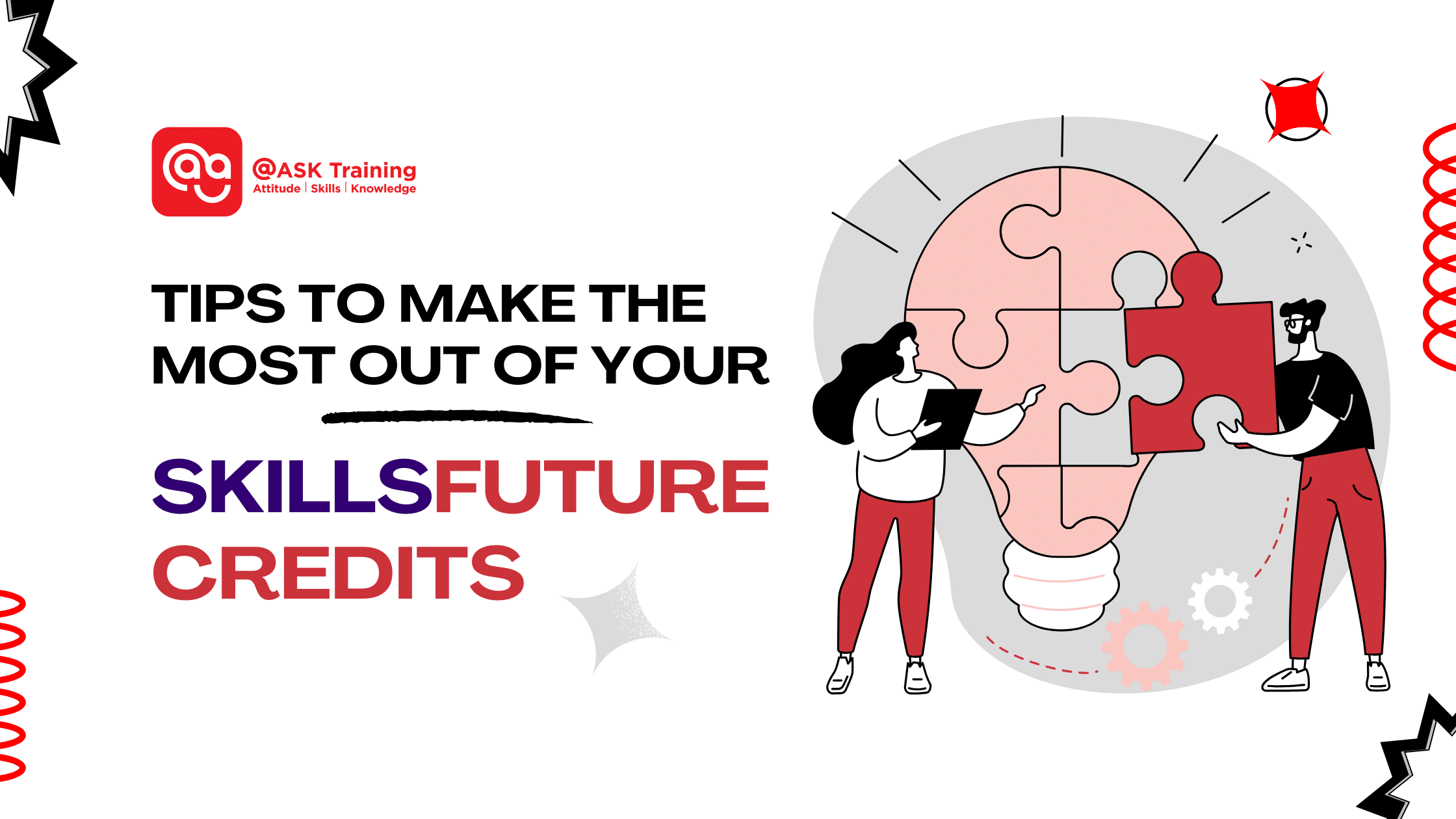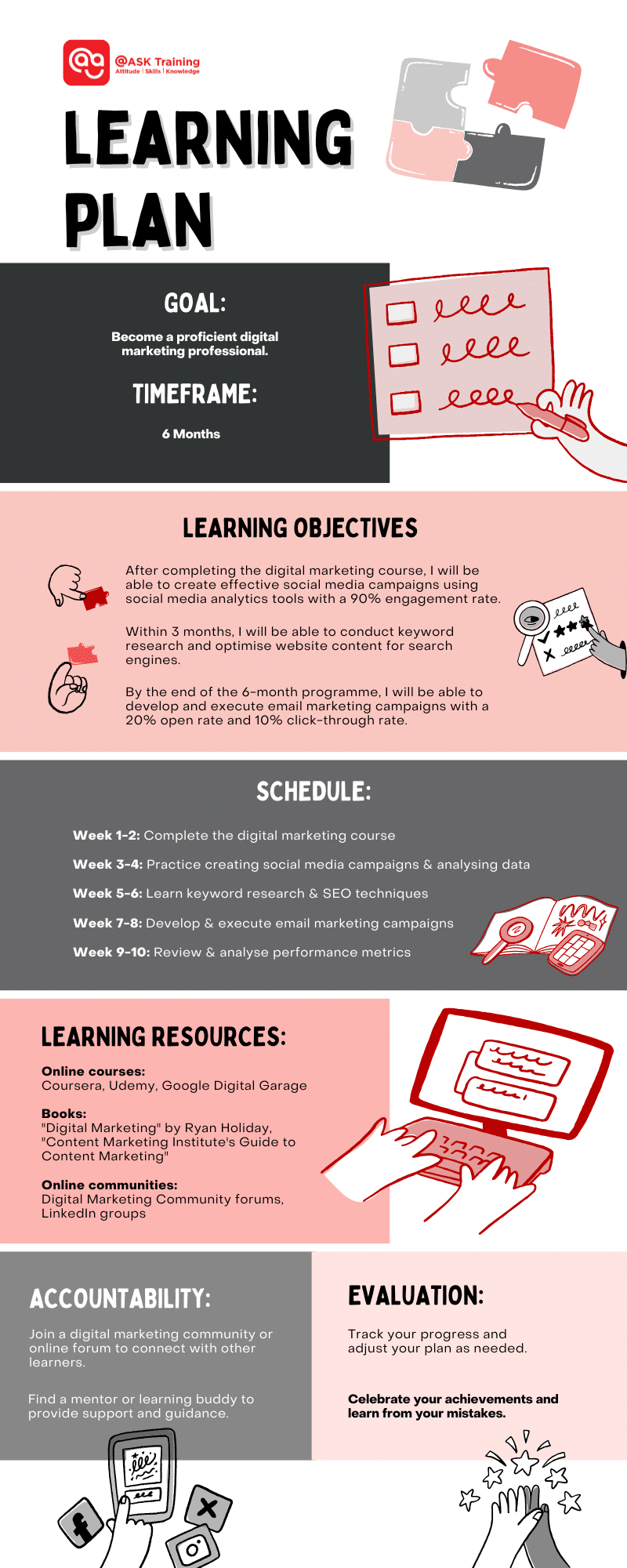We all feel a little bit rusty when it comes to learning new things to keep up with the job market today. Don’t let your education end after graduation. Continuous learning is the new normal and here’s where you can utilise your SkillsFuture Credits!
However, with so many options available, making informed decisions that truly benefit your career can be challenging. Don’t worry, we’ve got you covered.
This article will give you the tips you need to make the most of your SkillsFuture Credits and take your career to the next level.
Overview of SkillsFuture Credits
SkillsFuture Credit is a government initiative designed to help Singaporeans aged 25 and above upgrade their skills and stay relevant in the workforce.
Key Points You Need to Know:
Who is eligible?
All Singaporeans aged 25 and above can enjoy SkillsFuture Credits.
How much do you get?
- Initial Credit: You’ll receive a $500 credit when you turn 25. This credit never expires.
- One-Time Top-Up: If you were 25 by December 31, 2020, you got an extra $500. This is valid until December 31, 2025.
- Mid-Career Boost: If you’re 40 to 60 years old, you’ll get an additional $500 (valid until December 31, 2025) and starting from May 2024, you’ll get another $4,000 for selected courses.
By providing financial support for eligible courses, SkillsFuture Credit encourages individuals to invest in their professional development and enhance their career prospects.
In the next few sections, we will go through helpful SkillsFuture Credit tips. Let’s explore more.
Goal-Setting for Effective Credit Usage
Before using your SkillsFuture Credits, it’s crucial to establish clear and well-defined goals. Think of your goals as the GPS guiding you towards your desired destination.
Like a well-planned journey, setting short-term and long-term goals will help you make the most of your SkillsFuture Credits.
Short-Term Goals
Short-term goals are the stepping stones that lead you towards your desired destination. They’re achievable within a short timeframe and provide immediate benefits.
For example, if you’re currently a digital marketing professional, a short-term goal could be to refresh your social media marketing skills and keep up with the current trends.
Long-Term Goals
Long-term goals provide you with direction and motivation. They’re ambitious and may take more time to achieve.
Let’s say you’re looking to transition from a finance role to an IT specialist position, acquiring IT-related qualifications could be a long-term goal.
Examples of goal-setting:
- Short-term: Learn data analysis to enhance your problem-solving skills in your current role or enhance your digital marketing skills to stay competitive in the industry.
- Long-term: Transition from a marketing role to a product management position or start your own online business.
By setting clear goals, you’ll be able to make informed decisions about which courses to take and how to use your SkillsFuture Credits effectively.
Self-Assessment and Planning
Understanding your strengths, weaknesses, and interests is crucial for making informed decisions about your upskilling journey. It’s important to take a moment to reflect on who you are and what you want to achieve.
Self-Assessment
Consider using tools like the RIASEC test to identify your career inclinations and skill preferences. RIASEC categorises individuals based on their interests in Realistic, Investigative, Artistic, Social, Enterprising, and Conventional activities.
You can also reflect on activities you enjoy in your personal and professional life such as what tasks or activities you find most fulfilling.
Here’s a general checklist of Self-Reflection Questions you can ponder upon:
By gaining a boarder understanding of yourself, you can gain insights into your career preferences and explore potential career paths.
Planning
Once you have a better understanding of yourself, you can develop a personalised learning plan that maps out your SkillsFuture Credit usage.
Your learning plan should help you stay focused, organised and motivated throughout your upskilling journey. Here’s what you can include when creating your own:
Set Clear Objectives
- Are you aiming for a career change, promotion, or simply personal growth?
- Write clear learning objectives using the ABCD model:
| Audience | Who is the learner? | “As a digital marketing professional…” |
| Behaviour | What do you want them to be able to do? | “…be able to create effective social media campaigns…” |
| Condition | Under what conditions will they perform this behaviour? | “…using social media analytical tools.” |
| Degree | What level of performance is expected? | “…with a 90 engagement rate.” |
- Example Objective: After completing the digital marketing course, I will be able to create effective social media campaigns using social media analytics tools with a 90% engagement rate.
Self-Assessment
- From your self-assessment results, understand your current skill level and areas for improvement.
- List down what motivates and excites you to learn.
Research Available Courses
- Explore SkillsFuture Credit-eligible courses that align with your goals and interests.
- Consider factors like course content, instructor qualifications, and reviews.
Prioritise Courses
- Decide on which courses will directly contribute to the goals you’ve set earlier.
- Include factors such as time constraints and budget.
Create An Action Plan
- Break down your learning journey into manageable steps with specific timelines
- Establish milestones to track your progress
Evaluation and Reflection
- Regularly track your achievements and identify areas for improvement.
- Consider what you’ve learned and how it applies to your goals.
- Most importantly, celebrate your achievements!
Here’s an example of a learning plan:
By conducting a thorough self-assessment and developing a personalised learning plan, you’ve taken the first crucial steps towards achieving your career goals.
You’ll be well-equipped to maximise SkillsFuture Credits and achieve your career aspirations. Now, let’s move on to find and choose the right courses for you.
Finding and Choosing the Right Courses
Let’s explore the wide range of SkillsFuture Credit-eligible courses available. SkillsFuture Credits support various courses, from technical skills to soft skills.
Here are some helpful tips to consider when finding the right course:
Compare Courses and Training Providers
- Consider course content and relevance: Ensure the course content directly supports your career objectives.
- Evaluate the curriculum: Review the course syllabus to assess if it covers the necessary topics and skills.
- Check for practical applications: Look for courses that offer hands-on experience or projects to reinforce learning.
- Compare course costs and value: Factor in tuition fees, course materials, and any additional expenses.
- Evaluate the return on investment: Assess how the course will benefit your career and contribute to your long-term goals.
- Look for discounts or subsidies: Some training providers may offer discounts or subsidies for SkillsFuture Credit holders.
Select Courses Aligned with Your Goals
- Align courses with your objectives: Ensure the course content directly supports your career goals.
- Consider your learning style: Choose courses that align with your preferred learning methods (e.g., classroom-based, online, or blended learning).
- Evaluate the course duration: Ensure the course length aligns with your timeline and commitments.
Consider Course Ratings and Reviews
- Seek feedback from previous students: Look for reviews and testimonials online or through industry forums.
- Pay attention to course content, instructor quality, and overall satisfaction.
- Explore industry trends: Stay updated on emerging trends in your field and choose courses that align with future job demands.
After you have carefully considered these factors, you will have a clearer picture of finding the right course that aligns with your learning plan and utilising your SkillsFuture Credits.
While having a detailed learning plan is essential, it’s also crucial that you’re mindful of the common mistakes that might hinder your learning journey. Let’s discuss more in the next section.
Common Mistakes to Avoid
No doubt that SkillsFuture Credit encourages and supports your upskilling journey. However, it’s also essential to avoid common mistakes to ensure a smooth and beneficial upskilling experience.
Here are a few common mistakes to watch out for:
Failing to Plan and Prepare
- Don’t just wing it, take the time to carefully consider your goals and research available courses before making a choice
- Choose wisely to ensure the courses align with your career objectives and long-term aspirations.
Not Managing Your Claims Properly
- Keep your records organised by keeping a digital or physical file with all the relevant documents such as application forms, receipts, and approval notices.
- Always check the status of your claims and follow up with the appropriate authorities
- Avoid losing funds by scheduling courses within the validity period of your SkillsFuture Credit
Not Being Proactive in Your Learning Journey
- Be an active learner by participating in discussions, asking questions, and actively engaging with the course material.
- Avoid selecting irrelevant courses that don’t align with your career objectives.
- Seek feedback and reflect on your learning experiences.
Failing to Network and Collaborate
- Neglecting to inform training providers of your intention to use SkillsFuture Credits can lead to processing errors.
- Avoid missing out on opportunities to connect with fellow learners and expand your professional network.
Additional Tips:
- Regularly Review Your Learning Plan
At least once a month, take some time to assess your progress and make any necessary adjustments. This could involve adding or removing courses, changing the order of activities, or adjusting your timeline.
- Avoid Wasting Credits
If you’re unsure about a course, do your research and seek advice from others before enrolling. Consider the course content, instructor qualifications, and potential return on investment.
While SkillsFuture Credit offers a valuable opportunity to enhance your skills, it’s important to avoid common mistakes so you can make the most out of your learning and upskilling experience!
Wrapping Up
By following the tips and strategies outlined in this article, you can get the most out of your SkillsFuture Credit and achieve your career goals.
Key Takeaways
- Set clear goals: Establish both short-term and long-term objectives to ensure your training aligns with your career aspirations.
- Conduct a self-assessment: Understand your strengths, weaknesses, and interests to make informed decisions about your upskilling journey.
- Choose the right courses: Select courses that align with your goals, recognised qualifications, and have positive reviews.
- Avoid common mistakes: Be mindful of common pitfalls such as choosing irrelevant courses, not managing your claims, and not being proactive in your learning.
- Network and collaborate: Connect with fellow learners, attend industry events, and seek mentorship opportunities.
Remember, you’ve got this! With a little planning and effort, you can use SkillsFuture Credit to transform your career and achieve your goals!
@ASK Training offers a wide range of IT and Digital Marketing courses that are eligible for SkillsFuture funding and utilise your SkillsFuture Credit.
Get in touch with us to learn more about which courses catch your interest!
Related Courses
◆◆◆



